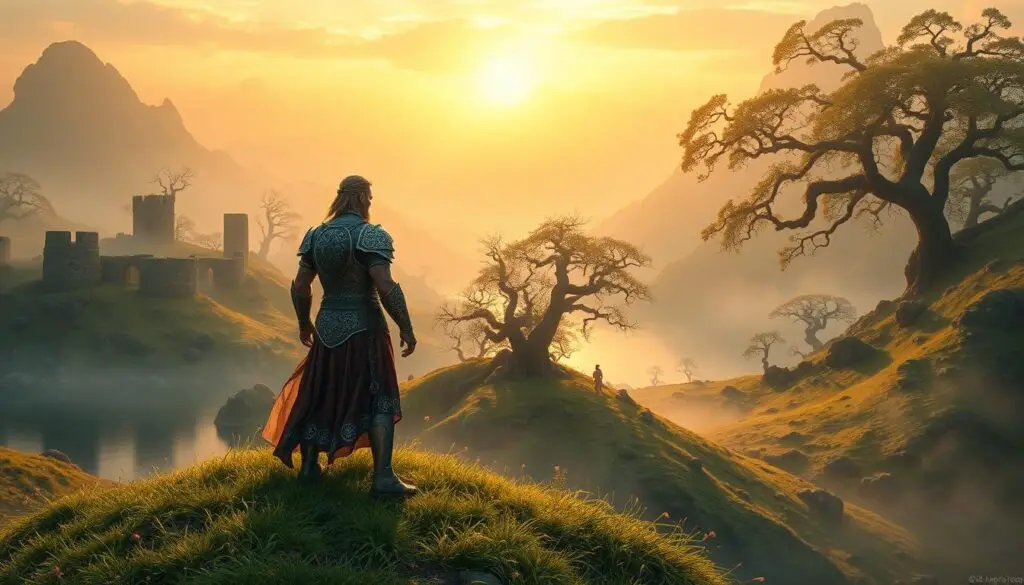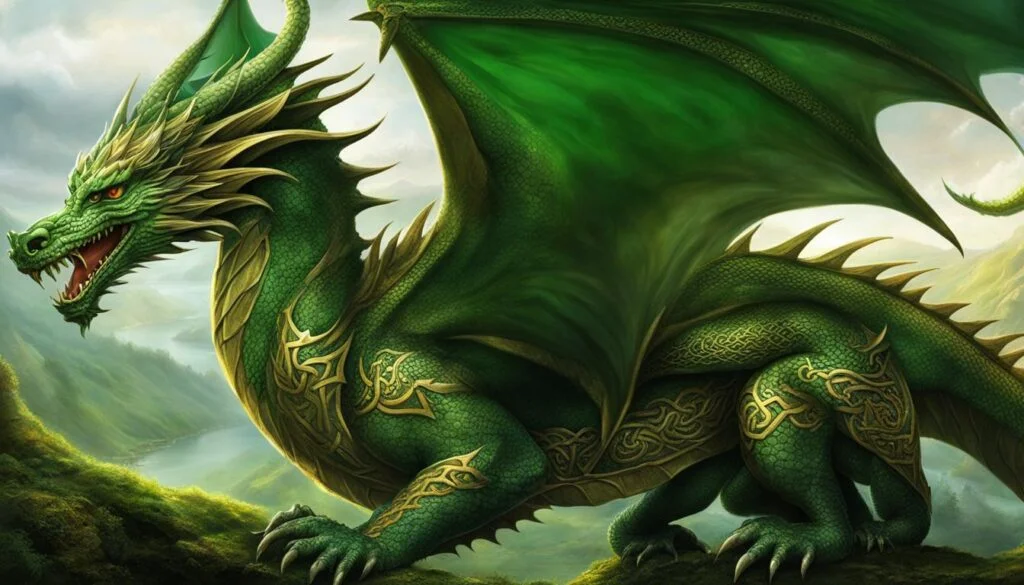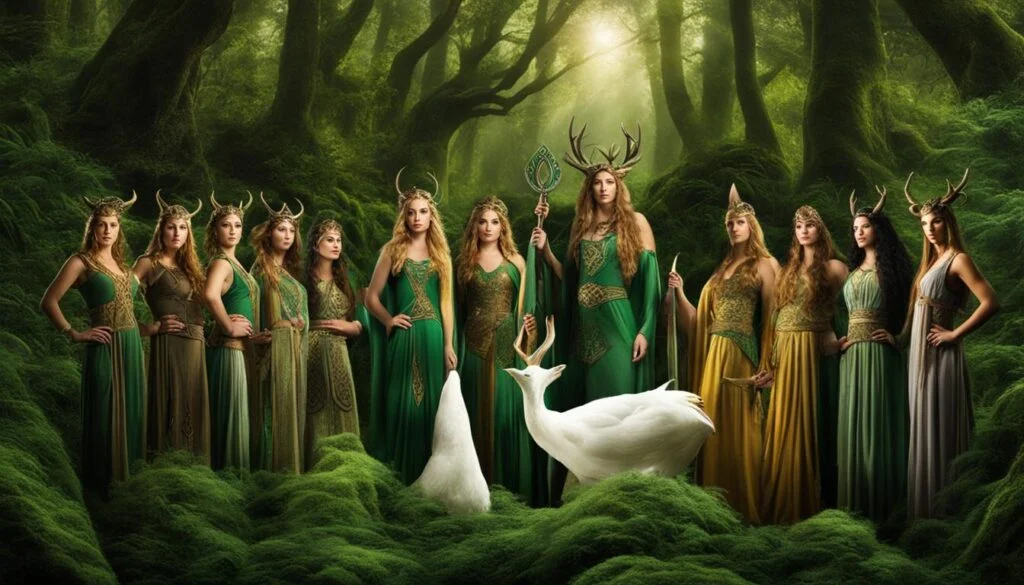Nemed is a key figure in Celtic myths. His story is deeply tied to Ireland’s ancient legends. He led the Muintir Nemid, or “people of Nemed,” to Ireland. This was after the Muintir Partholóin sadly died out.
The Nemedians sailed from the Caspian Sea with 44 ships. Only one ship made it to Ireland. It had Nemed, his wife Macha, and four sons.
Nemed and his people faced many challenges. They explored, fought battles, and built forts in Ireland. They cleared twelve plains and made two royal forts.
But, they also faced hard times against the Fomorians. This led to great loss and oppression.
Nemed died from a plague, marking a sad end to his story. Yet, his legacy lives on.
His descendants, the Fir Bolg and Tuatha Dé Danann, were key in later myths.
They left their mark on Ireland, with many places named after them.
Key Takeaways
- Nemed was the leader of the third group of settlers in Irish legend.
- The Muintir Nemid arrived in Ireland 30 years after the Muintir Partholóin.
- Only one of the initial 44 ships carrying the Nemedians reached Ireland.
- Nemed won four battles against the Fomorians, who were destructive forces in Celtic mythology.
- After nine years in Ireland, Nemed and 3,000 of his people died due to a plague.
- The Nemedians were oppressed by the Fomorians, necessitating a tribute of children, corn, and milk each Samhain.
- Nemed’s descendants, the Fir Bolg and Tuatha Dé Danann, became significant figures in later mythological cycles.
Origins of Nemed
The story of Nemed in Irish myths is full of deep history. It comes from the rich culture of pre-Gaelic Ireland. Nemed was a key leader in one of the five waves of invaders.
Etymology and Meaning
The name Nemed comes from the Old Irish language. It means “privileged” or “holy.”
This name is given to important religious figures, like druids, in Celtic stories.
The Proto-Celtic language also shows us where the name comes from. “Nemos” means “sky” or “heaven.”
This shows the deep spiritual meaning in Celtic beliefs and worship sites, known as “nemeta.”
Proto-Celtic Roots
The move from Proto-Celtic to Old Irish language shows a strong link between myths and the people of pre-Gaelic Ireland.
“Nemos” is more than just a word; it’s a symbol of the spiritual beliefs of ancient Ireland.
The Proto-Celtic language also shows how these beliefs continued through the Celtic invasions.
It influenced the myths and gods of the time.
Associated Deities and Ancient Worship Sites
“Nemeta” was the name for sacred places in Celtic Europe. These places showed how much Nemed’s people valued spirituality.
They had shrines and natural places that were sacred.
The name “nemeta” is also linked to the Rhine-area tribe, the Nemetes, and their god, Nemetona.
This shows how sacred sites were important in Celtic life, during invasions and otherwise.
Legend of Nemed

The legend of Nemed is a big part of Irish mythology. It’s found in the Lebor Gabála Érenn.
Nemed came from Japheth, who was Noah’s great-grandson. He sailed from Scythia to Ireland, becoming the third group to invade the island.
His journey was tough, with only one ship out of thirty-four making it across the Caspian Sea.
When Nemed arrived in Ireland, he and his people faced many challenges.
Mide, their top druid, lit a fire at Uisnech that burned for seven years. This fire lit the fires of every chief in Ireland, showing they planned to make a big impact with their ancient traditions.
Nemed and his followers fought the Fomorians in many battles.
They battled the Fomorians three times and lost a big defeat at Cnámross.
This defeat made them pay tributes to the Fomorians every Samain at Mag Cétne.
“The druid Mide once more lit a fire that lasted seven years, signifying the enduring spirit of the Nemedian people despite their countless adversities.”
The Nemedians wanted revenge and attacked the Fomorian tower on Tory Island.
But, they lost many and only thirty survived, spreading out across the world. Famous Nemedians include the poet Figma and the doctor Fergna, showing their cultural and smart impact.
Some stories link the Nemedians to the Érainn, a P-Celtic group.
Their stories of battles and spreading out add to Irish mythology. The Lebor Gabála Érenn shows how much Nemed and his followers influenced Irish myths and culture.
Nemedian Settlements in Ireland
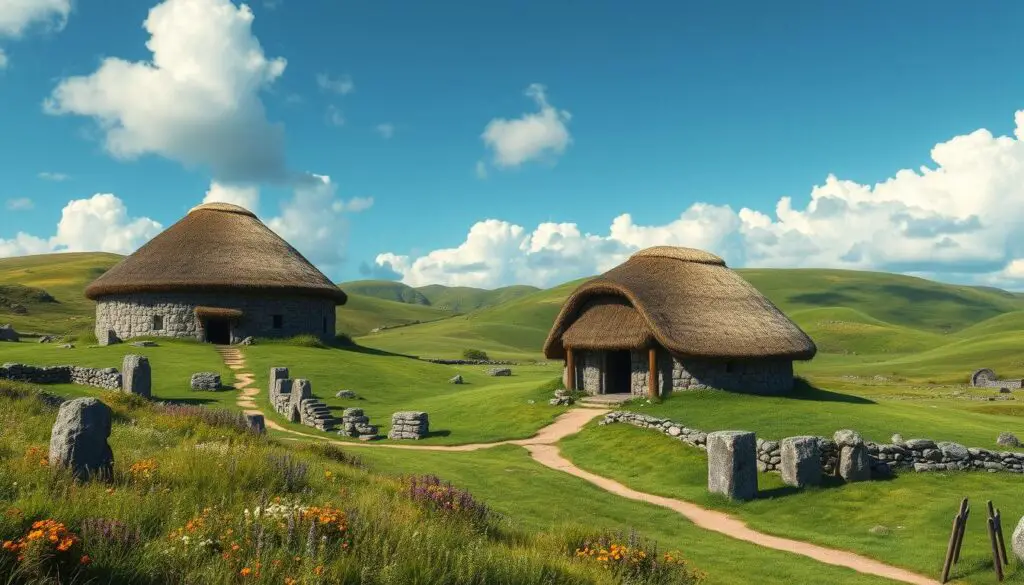
Nemed came to Ireland and started a new chapter in its history.
The Lebor Gabála Érenn tells of six waves of settlers, including the Nemedians. This was a key part of Ireland’s story.
Arrival and Exploration
Nemed and his wife Macha, their sons, and thirty-four ships arrived. They had thirty people in each ship.
They started to clear twelve plains of woods. This was a big job that helped them settle the land.
Settling the Land
After exploring, the Nemedians worked hard to make the land ready for living.
They settled in different places and changed the landscape. But, their story also tells of hard times and conflict.
Macha, Nemed’s wife, sadly died after twelve years. Some say she was killed by Balor, a powerful enemy.
This shows how their story was full of both progress and struggle.
Building Royal Forts
The Nemedians built famous forts like Ráth Chimbaith and Ráth Chindeich.
These forts were important symbols of their rule. But, the building of Ráth Chindeich was a sad event.
Nemed killed the four sons of Matan Munremar, who helped build the fort.
This shows the harsh ways of claiming land back then.
Conflicts with the Fomorians
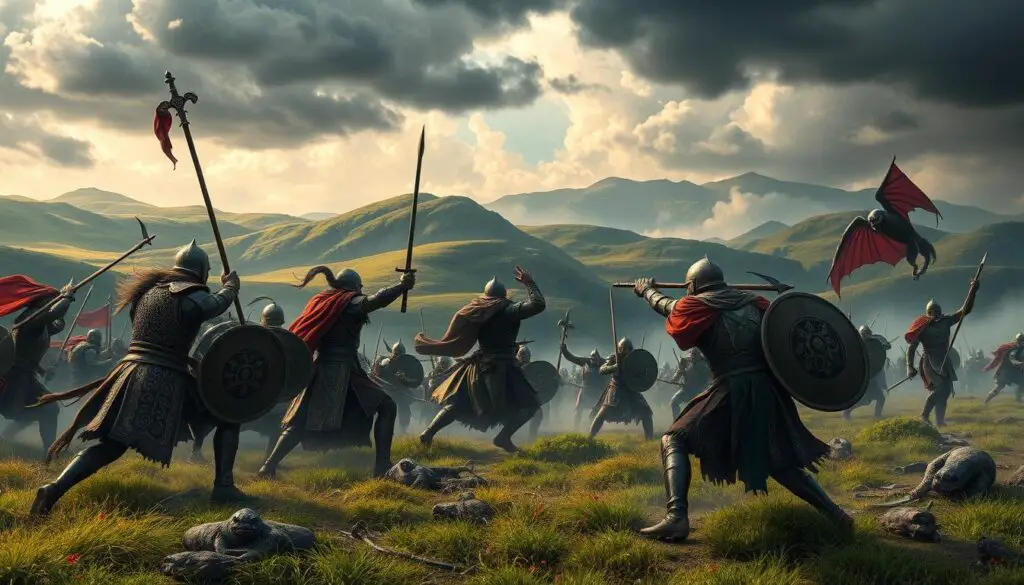
The Nemedians came to Ireland and started a long fight with the Fomorians.
These ancient battles in Irish mythology show the endless fight for power and survival.
The Fomorians, dark beings of chaos, led a strong force against the Nemedians.
The Four Battles
Four big battles showed the fight between the Nemedians and the Fomorians.
At Ros Fraechain, Badbgna, Cnamros, and Murbolg, the Nemedians fought hard.
They had up to 60,000 men and killed Fomorian kings like Gann and Sengann.
The Oppression by Morc and Conand
After winning at first, the Nemedians faced hard times. Morc and Conand, the Fomorian leaders, made them pay heavy tributes.
Nemed died from a plague, making things worse for his people.
During one hard time, almost 3,000 Nemedians died. This shows how tough their lives were.
The Uprising and Final Battle
Even with hard times, hope stayed alive. Fergus Lethderg, Nemed’s son, gathered about 60,000 men to fight the Fomorians again.
This final battle at Conand’s Tower showed their bravery and hope.
Though they won briefly, the Fomorians, led by Morc and Conand, beat them down. Only 30 people from both sides survived.
These ancient battles in Irish mythology show the deep struggles of the Nemedians.
These battles were full of heroism and sadness. They show the endless fight in Irish stories.
The fights with the Fomorians highlight the Nemedians’ strong spirit and the power of their enemies. This story adds to Celtic legends even today.
Nemed’s Legacy
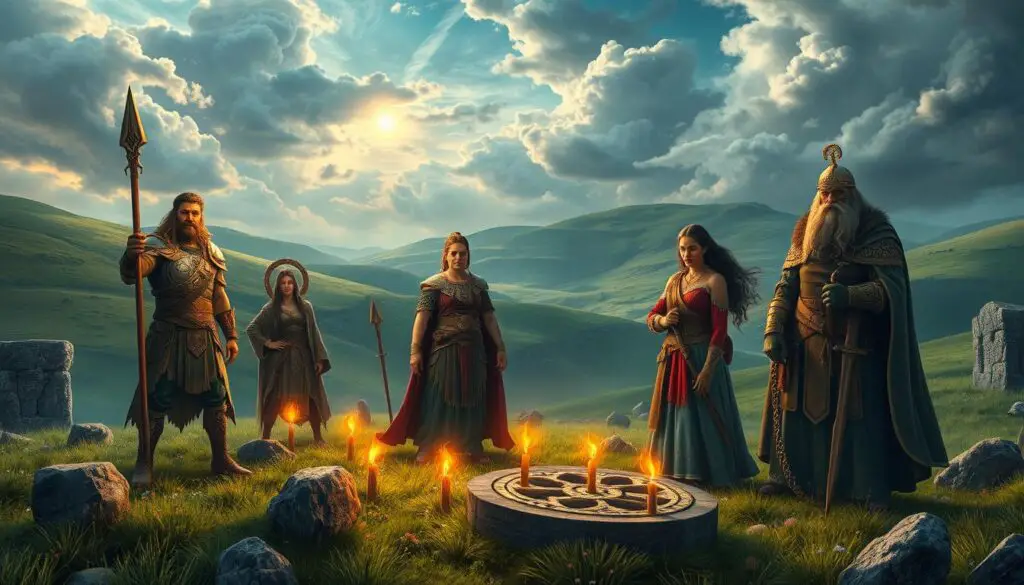
Nemed’s legacy lives on through his descendants. They split into two main groups: the Fir Bolg and the Tuatha Dé Danann.
These groups shaped Ireland’s mythological history. They kept Nemed’s family line alive.
Descendants: The Fir Bolg and Tuatha Dé Danann
The Fir Bolg were a group that settled in Ireland later. They came from the Muintir Nemid. After facing war and disaster, they went to Greece for 230 years.
Then, they sailed to Iberia and then to Ireland. They divided Ireland into five parts. Each part had a leader.
They ruled for 37 years under nine High Kings, including Eochaid mac Eirc.
The Tuatha Dé Danann were another group from Nemed’s line. They came from the north.
They are seen as the spiritual ancestors of the Irish people.
They fought in the First and Second Wars of Mag Tuired. They beat the Fomorians and the Fir Bolg in battle.
Impact on Later Mythological Cycles
The stories of the Fir Bolg and Tuatha Dé Danann are part of Irish myths.
These myths are in the Mythological Cycle, Ulster Cycle, Fenian Cycle, and Historical Cycle. They tell of Nemed’s descendants’ bravery and magical deeds.
The Mythological Cycle tells of the Tuatha Dé Danann’s divine roots. It shows their big impact on Irish myths.
This cycle is the oldest and sets the stage for the rest.
These stories have inspired Irish art and folklore for years. Nemed and his descendants’ stories show the mix of history and legend in Ireland.
They highlight the spirit and culture of the Irish people.
Historical Significance

Nemed’s story in early Irish history is a blend of fact and myth. It shows the Celtic people’s belief in many gods.
They worshipped over 300 different gods.
Nemed’s tale links myth to history, making prehistoric Ireland rich in myths.
The Dinnṡenchas tells 30 stories about the Tuatha Dé Danann. These stories focus on women, water, and wisdom in Celtic myths.
These stories are like “mythological geography.” They explain Ireland’s rivers and sacred places.
Figures like Dagda, a god of fertility and wisdom, show how history and myth mixed.
This mix helps us see what prehistoric Ireland was like. It shows us the society and beliefs back then.
Nemed’s story is a key part of Ireland’s history and traditions.
The Gundestrup cauldron, made between 200 BC and 300 AD, shows Taranis, the Celtic thunder god.
This links Nemed’s story to a wider historical time.
These legends let us see the mythical and historical sides of Ireland. Stories of the Tuatha Dé Danann and Tír na nÓg paint a picture of Ireland’s past.
They mix myth and history perfectly.
Nemed in Celtic Mythology
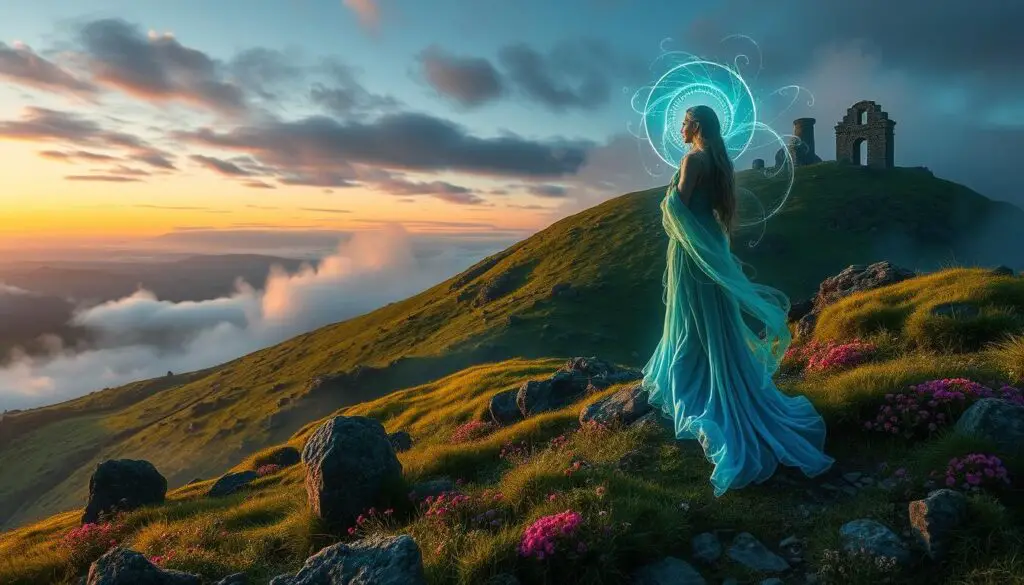
In Celtic mythology, Nemed is a key figure. His story is a big part of Ireland’s rich history. It tells us about the early settlers who shaped the island.
The Lebor Gabála Érenn, or “The Book of the Taking of Ireland,” tells us about Nemed. He came to Ireland with 30 ships, each with 60 people.
This started a time of great battles and important events in Irish stories.
Nemed and his people changed Ireland a lot. They made twelve new plains and four lakes.
They also had big battles against the Fomorians and won four times.
But, a disease killed Nemed and two thousand of his followers. The Fomorians then ruled over the Nemedians harshly.
They took two-thirds of all the children every seven years.
Thirty Nemedians escaped a flood and went to places like North, Greece, and Scotland.
They came back as the Fir Bolg and divided Ireland into five parts. Their stories add to the Lebor Gabála Érenn and show how settlers shaped Ireland’s culture and history.
Nemed: Real or Myth?
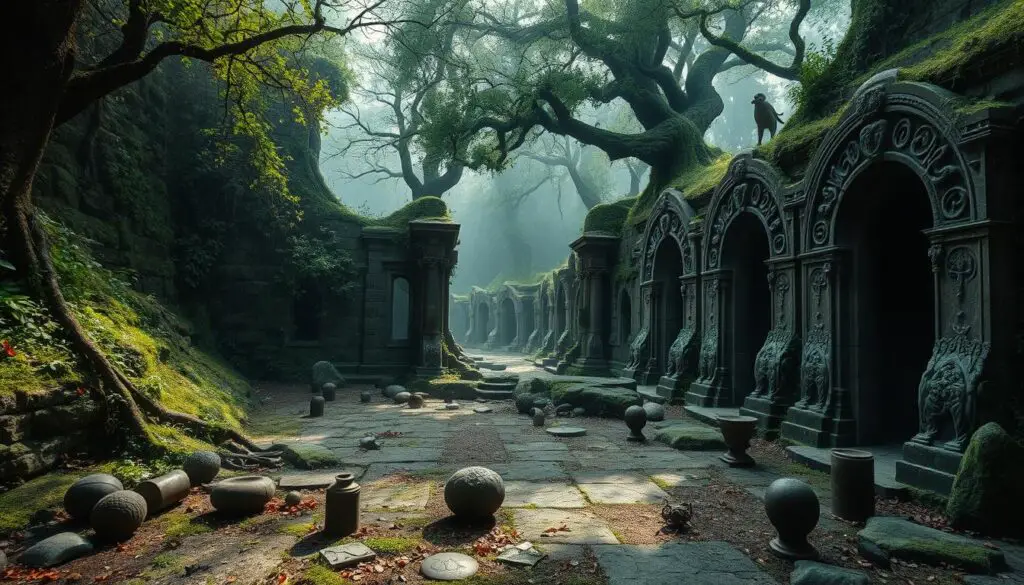
Nemed is a mysterious figure that mixes myth with possible history. Looking at old stories and digs gives us clues about his life.
Scholars argue about if he really existed, making us think about Irish myths.
Archeological Correlations
There’s no clear proof of Nemed’s existence, but some old finds are interesting.
For example, ancient settlements and artifacts in Ireland make researchers talk.
These finds don’t directly link to Nemed but help us understand the time back then.
This search shows how myths and real events mix, keeping us curious about old stories.
Influence on Irish Tradition
Nemed’s story has shaped Irish traditions, appearing in stories and customs.
These tales carry old wisdom and values, keeping Nemed’s legend alive.
The debate about his reality makes us value ancient stories more.
These stories show how old tales still affect our beliefs and values today.
Comparisons with Other Mythological Figures
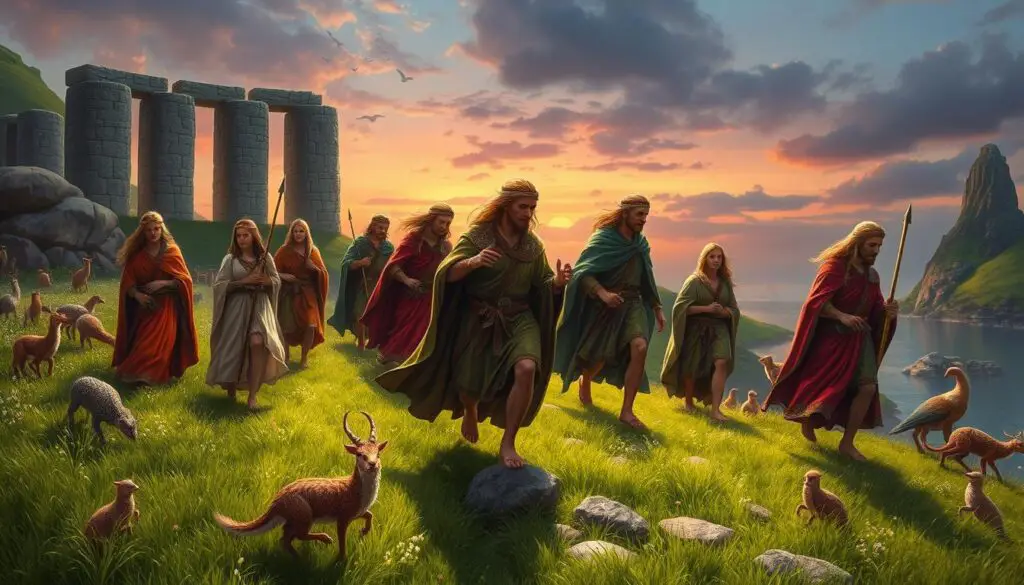
In Irish legend, many mythological figures are famous. But Nemed’s stories are especially interesting when compared to others like Partholón and the Milesians. This shows how ancient Celtic stories mixed in Irish mythology.
Nemed and Partholón
Nemed and Partholón are key figures in the Lebor Gabála Érenn, Ireland’s mythical history book.
They were both early settlers who played big roles in Celtic stories. Partholón was the first to settle Ireland and brought farming, cooking, and crafting.
But a plague killed his people, making way for Nemed.
Nemed came later and faced many battles with the Fomorians.
His story shows the fight against chaos and tyranny. Both Nemed and Partholón are vital in Irish legend.
Their stories talk about surviving, being strong, and the cycle of myths in Ireland.
Nemed and Milesians
The Milesians were the last group to settle Ireland, ending a long mythic journey.
Their stories are important because they show the start of Gaelic Ireland. They were seen as brave sailors who changed Ireland’s power and culture.
When we compare Nemed and the Milesians, we see a shift from myth to history.
Nemed fought supernatural enemies, while the Milesians won battles and settled the land.
This shows how different stories tell about different challenges and times in Irish stories. It helps us understand Ireland’s rich culture and myths better.
Conclusion
Ireland’s stories tell us about its deep culture and myths. The tale of the Nemedian race is a key part of these stories.
It shows both their victories and struggles.
Nemed and his people had big battles with the Fomorians. They left a lasting mark on Irish myths.
Their stories are still important today.
The story of Nemed fits well with Celtic traditions. Festivals like Samhain and Beltane show the cycle of life and death.
These stories talk about warriors and gods, showing their role in Irish myths.
Nemed’s story is still alive today. It shows how stories shape our values and dreams.
Ireland’s myths, including Nemed’s, teach us about human culture and the power of legends.
The tale of Nemed adds to Ireland’s history. It also makes us think about our shared culture and identity.
It’s a story that touches our hearts and minds.
Frequently Asked Questions
Q: Where did Nemed come from?
Nemed is a character from Irish mythology who is said to have come from the northern regions of the world, leading his people to Ireland after a series of wanderings and adventures.
Q: Who is the mother god Celtic?
Danu is often considered the mother goddess in Celtic mythology, associated with fertility, agriculture, and nurturing the land and its people.
Q: Who is the goddess of fury in Celtic?
The Morrigan is often associated with fury and war in Celtic mythology, known for her ability to influence the outcome of battles and incite warriors.
Q: Who is the most powerful god in Celtic mythology?
The Dagda is one of the most powerful gods in Celtic mythology, known for his control over life, death, and agriculture, wielding a club that could kill nine men with one blow.
Q: Who was the most feared Celtic warrior?
Cú Chulainn is one of the most renowned and feared warriors in Celtic mythology, famous for his superhuman strength and feats in battle.
Q: Who is the Celtic god equivalent to Thor?
Taranis is often compared to Thor because of his association with thunder and as a god of sky and weather in Celtic mythology.
Q: Are Celts Irish or Scottish?
The Celts were a widespread group of tribes with branches both in Ireland and Scotland, among other regions. Today, Celtic culture is most strongly associated with both the Irish and the Scottish.
Q: Who are the Celts descended from?
The Celts are believed to be descended from Indo-European peoples who spread across Europe, integrating with local cultures and tribes during the Iron Age.
Q: Who is the legendary Celtic hero?
Cú Chulainn, also known as the Hound of Ulster, is one of the legendary Celtic heroes noted for his tales in the Ulster Cycle of Irish mythology.


